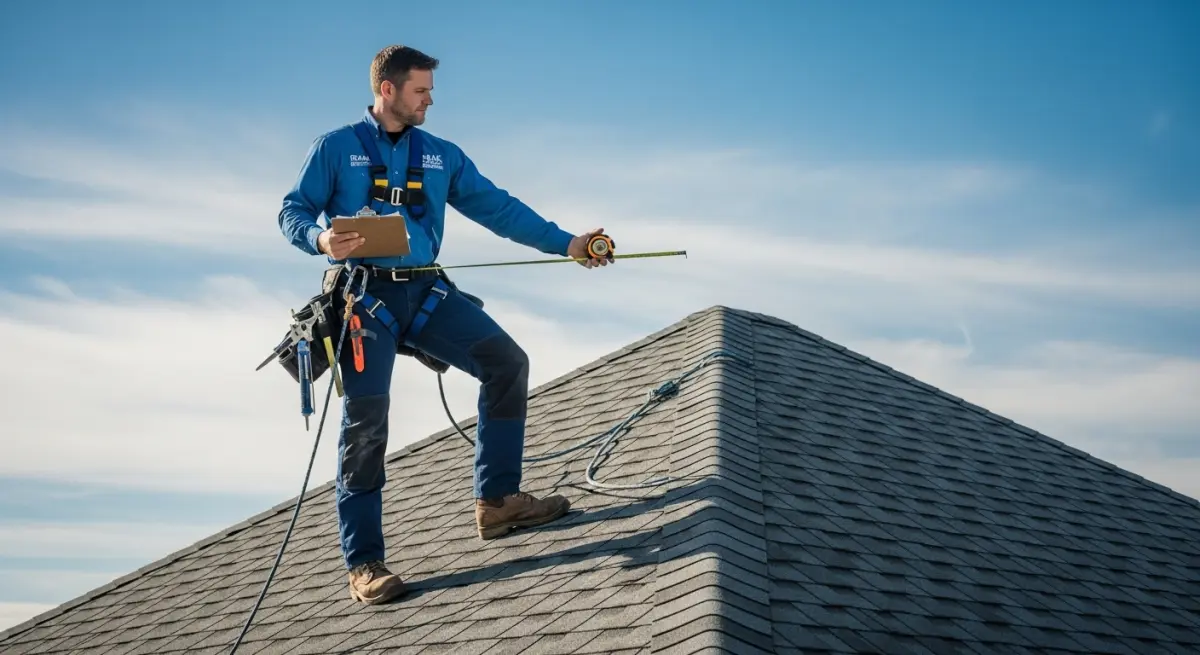Roof Flashing Repair 101: Fixing Leaks Around Chimneys and Vents
Roof flashing repair addresses one of the most common yet overlooked sources of roof leaks. Flashing—the metal or composite material installed at roof intersections, chimneys, vents, and valleys—directs water away from vulnerable areas. When flashing fails, water infiltrates beneath shingles, causing rot, mold, and interior damage. Understanding how to identify flashing problems and knowing when to repair versus replace saves thousands in water damage costs.
What Is Roof Flashing and Why Does It Fail?
Roof flashing creates a watertight seal where different roof planes meet or where penetrations interrupt the roofing surface. Chimneys, vent pipes, skylights, and valleys all require flashing to prevent leaks. Properly installed flashing should last 20-30 years, but several factors cause premature failure.
Improper installation ranks as the leading cause of flashing leaks. Contractors who skip critical steps like counter-flashing on chimneys or use inadequate overlap create immediate weak points. Material degradation from weather exposure, thermal expansion cycles, and UV damage eventually compromises even well-installed flashing. Understanding how to repair roof leaks starts with recognizing flashing as the likely culprit.
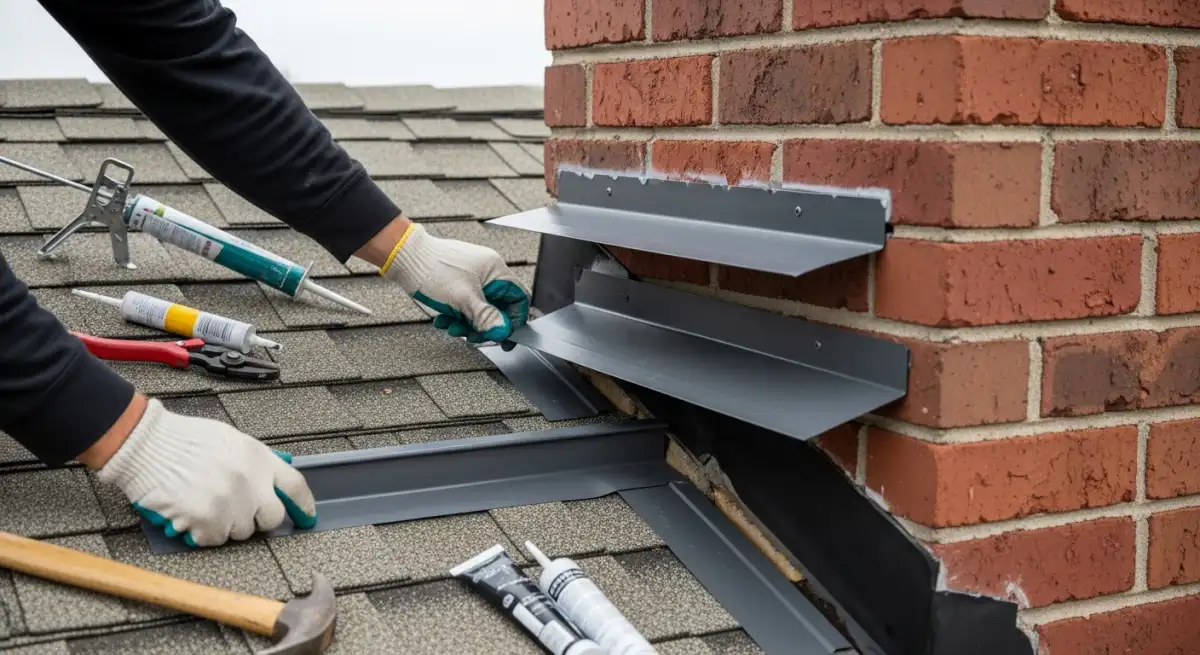
Common Causes of Flashing Failure
Northern Virginia's climate stresses flashing systems significantly. Freeze-thaw cycles expand and contract metal, loosening fasteners and opening seams. Summer heat bakes rubber vent boots until they crack. Wind-driven rain exploits any gap in flashing coverage. Ice dams force water under flashing edges designed only for downward water flow.
Physical damage from fallen branches, foot traffic during maintenance, or previous repair attempts creates punctures and tears. Settlement in older homes pulls chimneys away from the house, opening gaps that were once tight. Galvanized steel flashing rusts through after 15-20 years, while aluminum corrodes from contact with acidic chimney mortar. Even copper flashing, which lasts 70+ years, can develop pinhole leaks or pull loose from failed sealants.
Identifying Flashing Problems: Interior Warning Signs
Ceiling stains near chimneys or exterior walls signal flashing failure. Water running down the interior chimney face points directly to chimney flashing issues. Damp walls in attic spaces near roof penetrations indicate vent or skylight flashing leaks. Musty odors reveal hidden moisture from slow leaks that haven't yet created visible stains.
Peeling paint on ceilings or walls near roof transitions suggests ongoing moisture intrusion. Don't ignore small stains—they indicate leaks that worsen rapidly. A minor flashing gap becomes a major water damage project within months. Regular inspections help catch problems early when professional repairs cost far less than rebuilding water-damaged ceilings and walls.
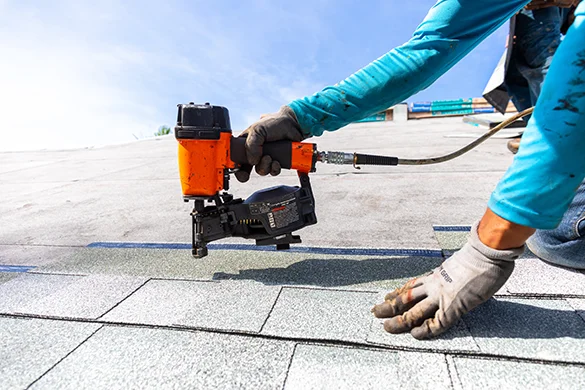
Chimney Flashing: The Most Complex System
Chimney flashing uses a two-part system that many homeowners don't understand. Step flashing consists of L-shaped pieces woven between shingles and installed up the chimney sides. Each piece overlaps the one below, creating a shingled effect that channels water downward. Counter-flashing embedded in chimney mortar joints folds down over the step flashing, preventing wind-driven rain from penetrating underneath.
Many chimneys lack proper counter-flashing because installers skipped this critical step to save time. Others show deteriorated mortar that no longer holds counter-flashing securely. Wide chimneys (over 30 inches) require a cricket or saddle on the uphill side to divert water around the chimney. Without this feature, water pools behind the chimney and eventually forces its way through seams. Proper chimney flashing repair addresses all these components, not just visible problems.
Vent Pipe Flashing: Simple but Critical
Plumbing vents use boot-style flashing with a rubber or neoprene collar that seals around the pipe. The metal base integrates with surrounding shingles to shed water. Vent flashing typically fails when the rubber boot cracks from UV exposure and temperature cycling. Northern Virginia's temperature swings—from winter lows near 0°F to summer highs over 95°F—accelerate rubber deterioration.
Cracked boots leak before you notice visible damage. Water runs down the pipe into walls and ceilings, causing extensive hidden damage. Fortunately, vent flashing repair ranks among the simplest roof repairs. Replacement boots cost $15-40, and the work takes under an hour for experienced roofers. Regular inspection every 3-5 years catches deteriorating boots before they fail and leak. Learn more about common asphalt roof repairs to understand complete maintenance needs.
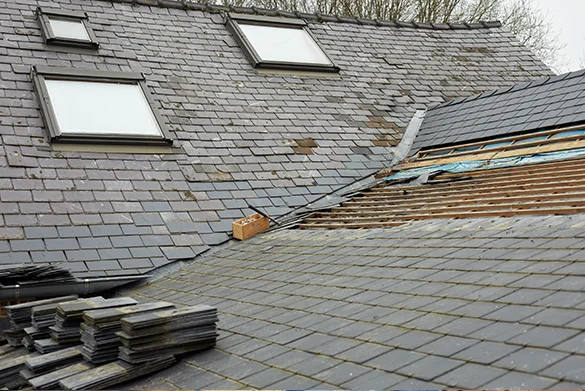
Skylight Flashing: Precision Required
Quality skylights include manufacturer-specific flashing kits with pieces designed for that exact skylight model. Installation follows a precise sequence: bottom sill flashing goes on first (over shingles), then side step flashing woven with shingles, and finally top head flashing (under shingles). Each piece integrates with the next to create a continuous weather barrier.
Problems arise when contractors substitute generic flashing for manufacturer kits or fail to follow installation instructions. Water penetrates improperly sequenced joints, causing leaks that appear to come from the skylight itself when flashing is actually at fault. Condensation inside the skylight shaft or stains around the frame indicate flashing issues. Skylight flashing repair often requires complete system replacement rather than spot fixes, making professional installation essential.
Valley Flashing: Critical Water Channels
Valleys collect water from two roof slopes, creating high-volume drainage channels. Open valleys use visible metal flashing (W-valley or standing seam profiles) that's easy to inspect and repair. Woven or closed valleys hide flashing beneath interlaced shingles, making inspection difficult without removing shingles.
Valley flashing fails when debris accumulates and traps moisture, when impact damage punctures metal, or when improper shingle cutting leaves inadequate flashing exposure. Ice dams in winter force water under valley edges designed for downward flow only. Metal valleys corrode over time, especially where dissimilar metals contact each other. Valley flashing repair ranges from simple debris removal and sealant touch-ups to complete metal replacement requiring extensive shingle removal. Understanding different repair approaches helps determine the right solution.
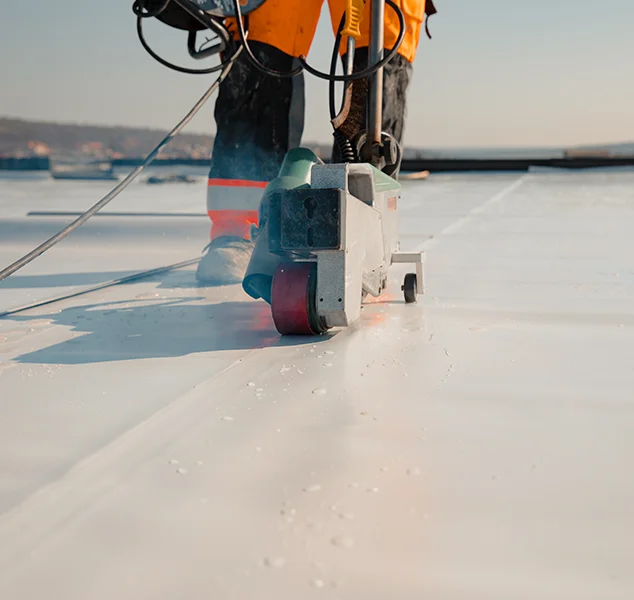
DIY vs. Professional Roof Flashing Repair
Simple vent boot replacement represents a reasonable DIY project for homeowners comfortable working on roofs. The process involves removing shingles above and beside the vent, pulling the old flashing, sliding new flashing into place, and reinstalling shingles. Total cost runs $20-50 for materials, and the work takes 1-2 hours with proper safety equipment.
However, chimney flashing, skylight flashing, and valley work require professional expertise. These complex systems involve multiple integrated components, precise installation sequences, and specialized tools like masonry saws for cutting reglets in brick. Mistakes cause leaks worse than the original problem and void any warranties. Most homeowners find that professional repair costs ($400-2,000 depending on complexity) prove worthwhile compared to potential water damage from failed DIY attempts.
Materials for Roof Flashing Repair
Galvanized steel remains the most economical flashing material at $2-4 per linear foot. It lasts 20-30 years in typical conditions but rusts eventually, especially where protective coating scratches. Aluminum costs $3-6 per linear foot and resists corrosion better while weighing less, though it's softer and dents more easily during installation.
Copper flashing ($15-25 per linear foot) represents the premium choice, lasting 70+ years with minimal maintenance. It develops a protective patina that enhances durability. Stainless steel ($10-18 per linear foot) provides excellent corrosion resistance without copper's high cost. Choose materials that match your roof's expected lifespan—copper makes sense for premium metal roofing but overkill for 20-year asphalt shingles nearing replacement.
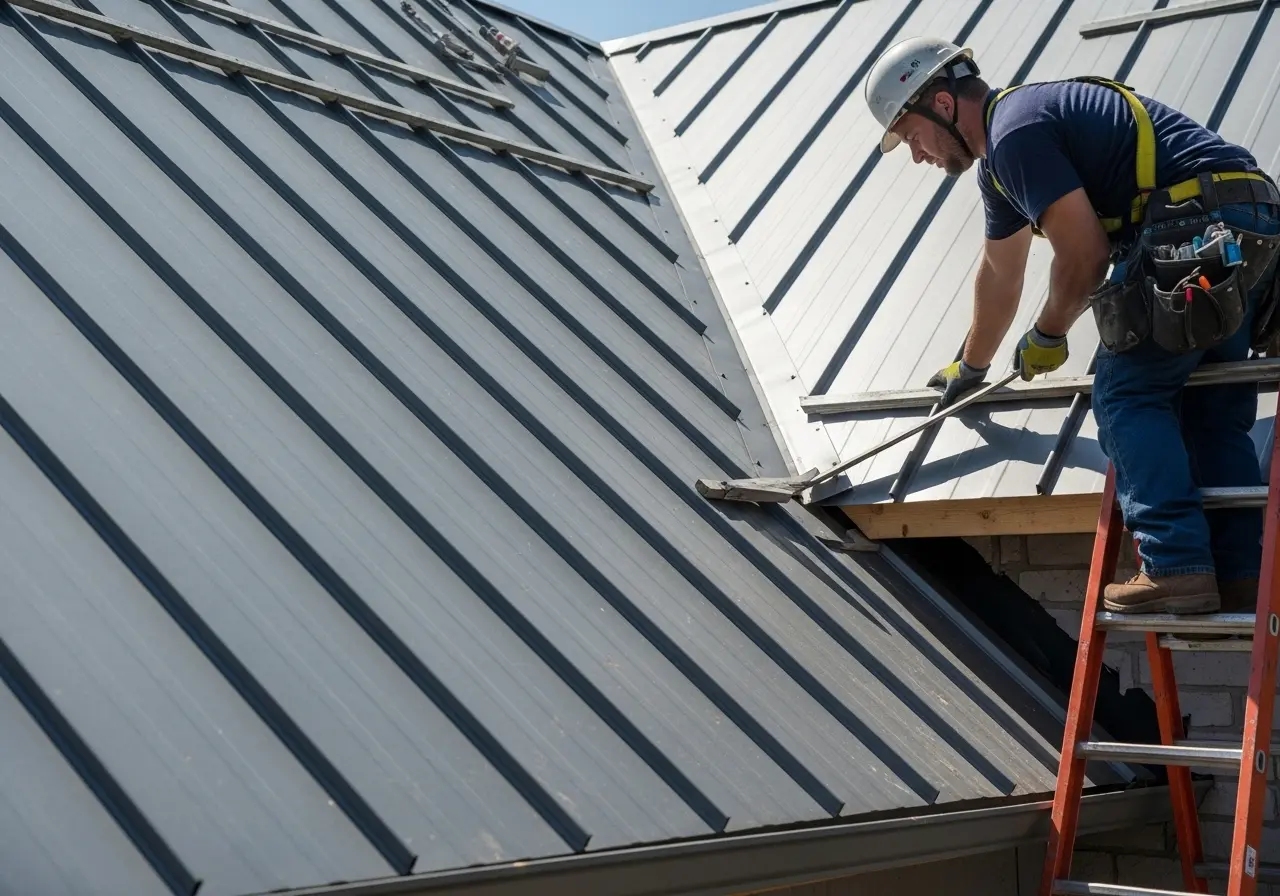
Cost of Roof Flashing Repair
Professional roof flashing repair costs vary significantly by complexity. Vent boot replacement runs $150-300 per vent. Chimney flashing sealant repairs cost $200-400 for minor work, while complete chimney flashing replacement ranges from $800-1,500. Skylight flashing repair costs $400-800 for minor issues or $1,000-2,000 for complete replacement.
Valley flashing repair spans $400-800 for partial work or $1,200-2,500 for full valley replacement. These costs include labor, materials, and any necessary shingle removal and reinstallation. While prices seem high, consider that preventing water damage saves far more. A single ceiling repair from leak damage easily exceeds $2,000 once you factor in drywall, insulation, painting, and potential mold remediation. Comparing these costs to full roof replacement expenses shows that timely flashing repair represents excellent value.
Preventing Future Flashing Problems
Annual roof inspections catch flashing issues before they leak. Walk around your property examining visible flashing for rust, gaps, or loose sections. Check attic spaces after heavy rains for water stains along chimney and vent areas. Clear debris from valleys and around chimneys that can trap moisture against flashing.
Address small problems immediately—a $200 sealant touch-up beats a $1,500 flashing replacement. Trim overhanging branches that drop debris and can physically damage flashing. Consider upgrading to premium materials during repairs—spending an extra $200 for copper instead of steel makes sense if it doubles flashing lifespan. Working with quality roofing contractors ensures proper installation that prevents recurring problems.
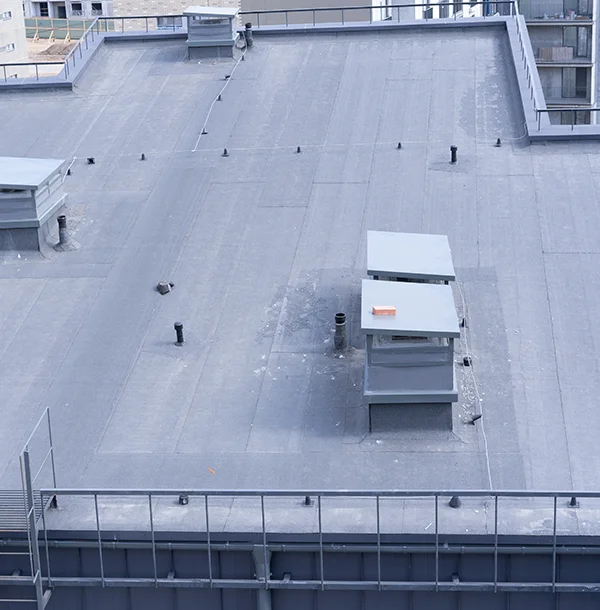
Flashing and Different Roofing Systems
Asphalt shingle roofs use step flashing at walls and chimneys, with rubber boots for vents. Metal roofing requires matching metal flashing—aluminum roof means aluminum flashing to prevent galvanic corrosion. Standing seam metal systems need specialized flashing profiles that integrate with panel ribs.
Flat roofing systems like TPO and EPDM use membrane-compatible flashings heat-welded or adhesive-bonded to the roof surface. These systems create fewer potential leak points than sloped roofs but require specialized installation skills. Understanding system-specific requirements ensures repairs match the original installation and maintain warranties.
Expert Roof Flashing Repair in Northern Virginia
Reston Roof specializes in diagnosing and repairing flashing failures throughout Northern Virginia. Our experienced team understands the nuances of chimney, vent, skylight, and valley flashing systems. We provide thorough assessments, transparent pricing, and quality workmanship that stops leaks permanently.
Serving homeowners in Reston, Fairfax, Arlington, and surrounding areas, we offer comprehensive flashing services including inspection, repair, and preventive maintenance programs. Contact Reston Roof at (571) 453-6515 for a free flashing inspection and honest recommendations that protect your home for years to come.
